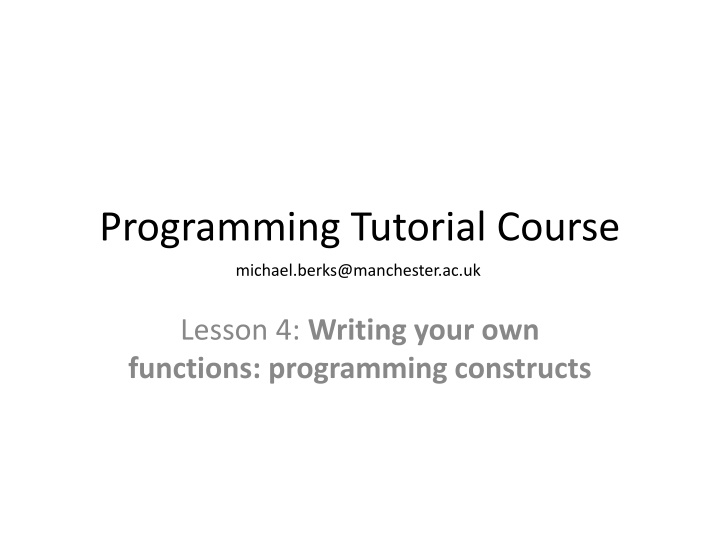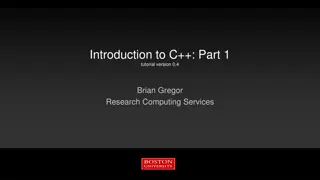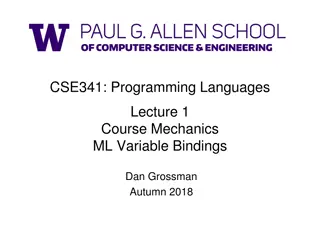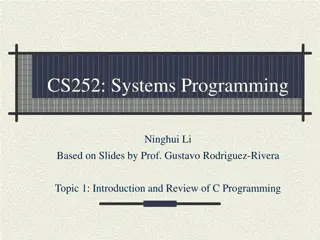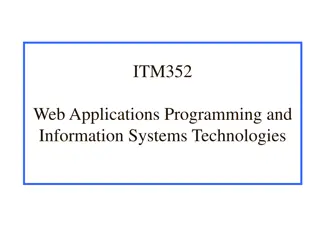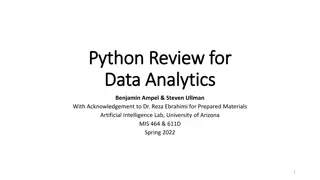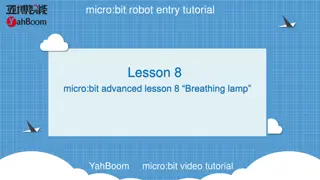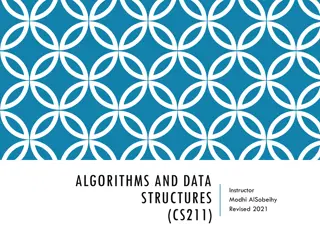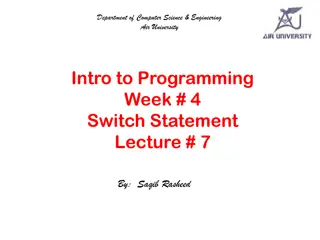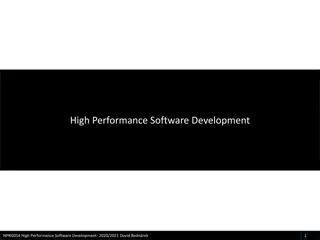Programming Tutorial Course
In this lesson, you will learn about programming constructs such as for loops, while loops, if/else clauses, switch statements, and control statements like break, continue, and return. Explore how to create functions in Matlab and Python to enhance your programming skills and efficiency. Practice exercises to reinforce your understanding and improve your coding abilities.
Download Presentation

Please find below an Image/Link to download the presentation.
The content on the website is provided AS IS for your information and personal use only. It may not be sold, licensed, or shared on other websites without obtaining consent from the author.If you encounter any issues during the download, it is possible that the publisher has removed the file from their server.
You are allowed to download the files provided on this website for personal or commercial use, subject to the condition that they are used lawfully. All files are the property of their respective owners.
The content on the website is provided AS IS for your information and personal use only. It may not be sold, licensed, or shared on other websites without obtaining consent from the author.
E N D
Presentation Transcript
Programming Tutorial Course michael.berks@manchester.ac.uk Lesson 4: Writing your own functions: programming constructs
Lesson Overview Writing your own functions: programming constructs For loops While loops If/else clauses Switch statements Control statements: Break, continue, return
Introduction So far we have seen how Matlab + python interpret and executes lists of commands combining Basic mathematical operators Our own functions Matlab/python s existing functions However, to do anything interesting, we need more options than simply running a sequential list of commands Applying one or more commands repeatedly Choosing to execute some commands and not others Programming constructs give us this flexibility Common to nearly all programming languages We ll look at Matlab/python s take on these
For loops Write a script to display I will not cut corners 100 times We could type the command: display( I will not cut corners ); x 100 not much fun! We could use cut and paste to help things along Or, as we re too lazy efficient to do that for itr = 1:100 display ( I will not cut corners ); end In python, try for itr in range(100): print( I will not cut corners )
For loops (cont) What if we want to do nearly, but not quite, the same thing on every line Try for itr = 1:100 display ( [ This is line num2str(itr)] ); end for itr in range(100): print( This is line , itr) What do you notice?
Exercises for loops Download the scripts loops_example.m and if_else_example.m(.py), run the code Download the function, roll_a_dice.m(dice_rolling.py), this simulates rolling a dice to return an integer between 1 and 6 Write a function to show the result of rolling a dice 5 times. When your functions runs it should produce a result like: Roll 1, you scored 3 Roll 2, you scored 1 etc Change the function so it has an input that specifies the number of rolls Hint: use the examples in the scripts to help you. Bart may also provide some assistance!
For loops general template for iter_var = A %Lines of code that do stuff end We call this a control block Is equivalent to repeating the code in pink (the control block ), once for each column in A At the start of each repetition, iter_var takes the value of the next column in A
iter_var = A(:, 1); %Lines of code that do stuff iter_var = A(:, 2); %Lines of code that do stuff iter_var = A(:, end); %Lines of code that do stuff
For loops - notes A can be any array Most common to use simple row vector of increasing integers (like our first examples) But could use string (i.e. char array) or cell array The code in the pink box can be any valid Matlab commands Including another loop or any of the control statement we cover today It can also modify iter_var or A but DON T DO THIS!!! See examples in loops_example.m
For loops general template for iter_var in iterator: %Lines of code that do stuff So is this : This indentation is important python control blocks are determined by their indentation! Repeat the control block in pink, once for each value in the iterator Iterator can be different types of object Most common usage range, a list or tuple See here for a tutorial on general iterator objects https://www.geeksforgeeks.org/iterators-in-python/ Also see enumerate: https://www.geeksforgeeks.org/enumerate-in-python/ My favourite python trick!
While loops For loops mean we need to pre-program how many iterations we have Sometime we want more flexibility than that Imagine we want to simulate rolling a dice until we score a six The number of times we repeat the action (rolling a dice), depends on the outcome of that action (the score of the dice) While loops allow us to do this
While loops general template while condition %Code that has potential to make condition false end while condition: #Code that makes condition false Condition must be a command that returns a true/false output The pink block keeps repeat as long as condition is true This means at some point something in the pink block must make the condition false or we ll loop forever!
Exercises while loops Now write a function using a while loop, to simulate rolling a dice until you score a 6. The output of your function should look something like: Roll 1, you scored 5 Roll 2, you scored 6 Modify the function so it counts the number of rolls it took to win Add code to tell the player they have won Congratulations, you won after 2 rolls!! Return the number of rolls as output to the function
If clauses Often we want only want to execute a bit of code when some condition is true We can use an if clause if condition %Code only runs if condition is true end if condition: #Code if condition is true
If/Else clauses Often, we also want to specify some alternative commands to run if condition is false We match the if with an else if condition %This code runs if condition is true else %This code runs if condition is false end See if_else_example.m if condition: #Code if condition is true else: #Code if condition is false
Elseif Sometimes we want to sequentially test different conditions if condition1 %This code runs if condition1 is true elseif condition2 %This code runs if condition1 is false AND condition2 is true else %This code runs if condition1 AND condition2 are false end This is just a shortcut, for nesting loops see example in if_else_example.m if condition1: #Code elif condition2: #Code else: #Code
Exercises while loops and if/else Now write a new function, that specifies a maximum number of rolls as input. If the players scores a 6 they win as before. However, if after the n-th roll they still haven t rolled a 6, then they lose The final display of your output should either be Congratulations, you won after 2 rolls!! Or I'm sorry, you used up 5 rolls without scoring a 6. You lose!! Hint you will need to use if/else statements When you have finished, download all the rolling dice functions, these provide my sample answers and will be useful for you to keep
Summary For loops, while loops, and if/else statements give you all the flexibility you need to write any program Each keyword ( for , while , etc.) must be matched with an end end s are matched to the first keyword above it The code between to keyword and its matching end is often called a control block Indenting your code will make it much easier for you to keep track of which control block any line of code belongs to Python doesn t use end (or any other symbol) to end control blocks Blocks start with a key word ( for , while , etc.) followed by : Control blocks must be tabbed to the same indentation So you have to indent your code properly!
Summary The function loopy_min combines the ideas we ve explored so far Note how loopy_min is redundant because of Matlab/numpy s min function? Also, remember the element-wise operations on arrays? Good Matlab and python programming means we often don t need loops!
Other controls We ll finish this lesson by looking at a couple of other control statements These aren t really necessary in that you can always code their equivalent using for, while, if etc. But you may find them in other people s code And they can provide shortcuts or improve the readability of code
Switch statements Consider a whole bunch of if/else statements of the form if var = val1 elseif var = val2 elseif var = val3 elseif var = valn else end
Switch statements (cont) We can rewrite using a switch statement switch var case val1 case val2 case val3 case valn otherwise end no switch statements in python!
Switch statements (cont) case and otherwise are also keywords The statement behaves exactly the same as the if/else code in the previous slide The otherwise takes the place of the final else and is applied if var does not match any of the specified values Like the else it is optional Switches are particularly useful when matching strings, as it saves having to use strcmp in each if condition See if_else_example
Continue, break, return Finally, there are three more keywords that allow you to move between control blocks (same in Matlab and python) continue When called in a loop s control block, skips any remaining commands in the control block and continues to the next iteration of the loop Usually used with an if clause to avoid processing bad data How else could we write this? break When called in a loop s control block, skips any remaining commands in the control block and terminates the loop return When called in a function, immediately terminates the function If the function has outputs, these must have been set before the return is called In python, outputs from the function are listed after return
Exercises 1 loading .mat files Download the zip file retinograms.zip into your data folder and extract the contents. This should generate an images folder with 20 .mat files Write a script to load in and display each image in a new figure use imshow Modify the script to convert each image to a grayscale image (hint: use rgb2gray see skimage.color in python) and save the new image in png format
